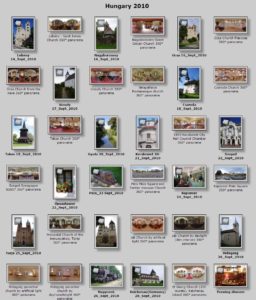To download a printable Adobe Acrobat version click on this link E2EYr9Weeks18-22.pdf (seven A4 pages)
Clicking on the underlined links in the text will take you to a selection of photographs. There is a comprehensive list of photographs and 360° panoramas
There is also an approximate map of our route around Hungary
Although it was a fairly impulsive decision to spend some of September seeing Romanesque churches and art nouveau architecture in Hungary, we were better prepared for this car journey than on our earlier trip to Portugal. We had enough time to update our European road maps (discovering in the process, the Michelin Europe didn’t include most of Hungary), get a more detailed folding map of Hungary, and rent a month’s Hungarian download for Gladys, the sat-navigator. Following old habits, we also stocked up on Lonely Planet guides to Hungary and Germany (more recent editions than the relevant Rough Guides), though during the journey we began to wonder if we’d reached the sad age of no longer being Lonely Planet people, as we wanted better information on art, architecture and parking (rather than tips on best bars and breast-feeding).
September can bring rain or glorious sunshine, and we got a mixture. We were fortunate to have some lovely sunny days, for also we got our share of rain and saw maize crops devastated by a summer of the heavy rain which probably also played a part in the current disaster of overflowing toxic red sludge at Ajka.

Lebeny
We spent a day and a half driving through Germany (wet) and across Austria (sunny). When we reached Hungary we had a rough itinerary, which included the eleven Romanesque churches which looked the most interesting on the internet, – especially those with fresco fragments. Many sounded as if they were in small villages or had formed part of remote hillside monasteries, and only three were mentioned in the Lonely Planet. So we wondered how easy it would be to locate and communicate with the keyholders. The Lonely Planet’s “conversation and essentials” section equipped us to state in Hungarian “I’m allergic to contraceptives” or “I need disposable nappies” but not to ask how we could see inside the beautiful church. However we soon found that the keyholders were the most delightful people, keen to communicate with the most oafish non-Hungarian speakers, and others helped through mime or a few shared words of German. These are three samples of our Romanesque quest:
Picture a small former mining (gold, copper, sulphur, and iron) village, Nagybörzsöny, in the north, hard against the border with Slovakia, on a wet third day. We spot the walled church at the entrance to the village, and pull in under a dripping tree. Despite the rain, we can see plenty of people with baskets, packages and bicycles further down the road. The locked gate is festooned with sodden red and white flowers, ivy and ribbons. There is a notice with a phone number, but we fail to get through on our mobiles. As we peer through the metal bars, a row of stone heads round the apse grins back at us. This is too good to miss. We walk towards the centre of the village to ask about keys. However, two buses have come and gone while we were trying to phone, and now the street is deserted. Some of the smallest thatched cottages are also empty, or just being used for storage. We pause as John spots a huge snail on a gatepost, and a man who has just got out of a car (but is unfortunately not from the village) engages in a rather surreal conversation in German about snails, the size at which they should be eaten, and how all Hungary’s get sent to France. We try doorbells, but nobody answers. We spot a lady pushing her bike up a hill and catch up with her. She does not appear to understand our questions and points to her bicycle basket. She has been out collecting walnut windfalls.
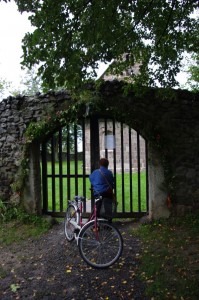
Nagybörzsöny
Suddenly she smiles triumphantly, opens her large handbag and flourishes a heavy key. It is hard to believe that the only person that we meet on the streets (apart from the snail-fancying outsider) just happens to have the church key in her handbag! She cycles ahead of us to open up. The church is tiny, with a single apse, white walls, simple wooden benches, a small gallery at the back and spotless white cloths on the altar and tables. There is no hint of damp and it feels loved and used. To the left of the altar is an imposing bust of St Stephen of Hungary, and to the right a replica of his crown and a Hungarian flag, for this is St Stephen’s Church and it was he who established Christianity in Hungary and ordered the building of a church in one of every ten villages. As John wanders round taking photos, the lady chats in Hungarian to me, not minding that I don’t understand much. She says that they celebrated a wedding recently (hence the flowers), and as we leave, she points at the sculpted heads outside. “Tartars”, she says. The rain still falls.
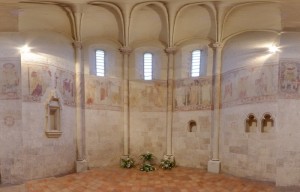
Ócsa frescoes
By afternoon, it feels as if we are in another land as we approach Ócsa, south of Budapest. The sun is shining, the sky is blue and ladies in hot pants and spangled bras stand by the road, unbuttoning their blouses provocatively at passing cars and lorries. The church here is much loftier, with three aisles and two towers, and was built as a Premonstrian monastery on a sand-dune in the marshes, using stone brought down the river from Buda. Outside, the stone glows lemon-gold in the afternoon light, and inside faint reds and yellows on the choir walls take the shape of mediaeval figures – Jesus crowning Mary, the disciples, fragment of the last judgement, St Ladislaus I of Hungary on his white horse, St Nicholas and St. George (look, no dragon). When the Turks occupied the area, they whitewashed over the murals and used the church without destroying it (apart from sharpening their weapons on the stone by the doorway). Unlike this morning, the telephone number on the door worked and Judit is a mine of information, which she is anxious to communicate. She has clearly looked up all the technical and architectural terms in English, but finds the verbs and joining words harder. As John takes photographs, she confides that the church has become very important to her, although she is not a Catholic or Reformed (which the church became after the Turks left and new people repopulated the area) but a Baptist (with an uncle who is a Baptist in the USA and knows Billy Graham). The church has a congregation of 300, 100 of whom are young people, and the choir has produced a CD. We continue to feel a world away from St Stephen’s this morning, as we thank Judit profusely for our informative guided tour.
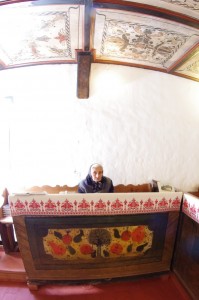
Tákos
Two days later we realise that the easiest time to see the lovely old churches is at the weekend, where local guides are on hand to instruct coachloads of Hungarians with a half hour lecture before they are allowed to look round. It is Saturday, and sunny and we have reached the Bereg region in the north east corner of Hungary (close to the borders with Ukraine and with Romania), where the Lonely Planet promises village life “steeped in folk culture, replete with dirt roads, horse-drawn carts and little old churches … where some women still eke out a living embroidering pillowcases in age-old patterns and men work the land.” This sounds to us like the scenes we glimpsed from the train as we travelled north in Romania, and we are looking forward to staying in the area, and exploring in a leisurely fashion. We stop first at Tákos to see the small white wattle and daub Reformed church, dating from 1766, and find that it is not only open but its pews are crammed with visitors listening to an old lady in a black headscarf holding forth authoritatively and at length. As we wait outside we are amused to see the embroiderers rush out as soon as coaches are heard to drape themselves and their cross-stitch embroideries picturesquely over plastic garden benches. After the second coach-load has left, we have a few minutes in which to revel in the painted wooden ceilings, pews, gallery, pulpit and huge high-backed seat and the red, white and blue embroidered cloths. It reminiscent in its painted simplicity of some of the old wooden Swedish churches. The old lady, takes one look at us, decides her words will be of no use, and waits patiently for proper visitors. When we go outside the embroideries and plastic chairs have disappeared.

Csaroda
At the next village of Csaroda we are back to Romanesque, this time in a beautifully tended garden. Here too, the church doors are open and another shrill, but more elegant church guide is holding forth. The inside is lovely, with its fourteenth century frescoes uncovered from beneath flamboyant seventeenth century red tulips and leaf patterns. St Peter and St Paul smile on the north wall below the tulips, together with Job, two Byzantine “doctor holies” (as the useful English printed summary describes them) and a “woman holy.” At the front are the 12 disciples and the suffering Christ, and on each side of the window recess a crowned figure. Together with the embroidered cloth and the rugs, the effect is colourful and exotic.
And meanwhile, how were we getting on with finding accommodation? On our first night we’d realised that the Lonely Planet’s selection of hotels and pensions in pretty mediaeval towns didn’t work for us if the area is pedestrianised and all parking occupied (besides, we hadn’t worked out meters or parking permits) and we followed a sign to a more conventional business type hotel. Our second night was in a huge room in a family hotel near the Slovak border. On our third night, after the glories of Nagybörzsöny and Ócsa churches, we headed east towards the mountains and chose the Panorama Pension and a room with a wonderful view. It is also an activity centre complete with a summer bob-sleigh-on-tracks run. The staff spoke no English or German, but were determined to be helpful. It transpired that we were their only guests. Yes, we could have dinner, but the chef finishes at 6pm. We drove down a winding road to the small town for dinner (deer casserole served by a caricature waiter, – fat, boozy and cross-eyed). We felt very solitary as we returned to our dark mountain retreat as the rain set in. By morning the view had disappeared completely under low cloud, which was a shame. As we approached Tokai on our fourth night, it was obvious that the main tourist season was over and we were a rarity. A sign outside a neat house offered rooms, and though Angie and her husband were in Germany, her daughter made us welcome us and laid on a wonderful breakfast in the family kitchen (by contrast we dined and sampled Tokai wine in an elegantly gloomy four star hotel). So all relatively simple and varied so far. But unfortunately, after the wonderful churches (and embroideries!) of rural Csaroda we run into problems, as the only lodging house, opposite the church, is closed. We find a rather sleazy hotel in a nearby village, but there is something unsavoury about the unshaven young man who emerges from the bar, and it can provide neither evening or morning meals. And in the nearest town, there is a big fair and all hotels are fully booked. We drive south, as the light fades and the rain starts to pour down. For miles we find no signs for rooms, let alone pensions or hotels. By now we are out of the pretty “peasant” area and on the edge of a town, with hotels with flashing night club signs. My memories of the Hubertus will be of a chain-smoking, but very kind, manageress (who fits my stereotype of a brothel madame as she leads the way up the dark panelled staircase with its worn red carpet), a bathroom with a peach suite and a turquoise shower curtain plus red velvet curtain to draw in front of the loo, and the most disgusting deep-fried wiener schnitzel and chips (Little-Chef style). So much for the LP’s “The pleasures of far, far north-eastern Hungary are simple and rural ones.”

Gyula cake shop
However, the LP is very good on highlighting two things, – art nouveau buildings and good cake shops. When we reach the south, we intend to focus on the towns of Kecskemét, Szeged and Pécs with their art nouveau palaces, cinemas and synagogues. And en route John is keen to experience the Great Plains. Having abandoned the embroideries and horse-drawn carts of the north-east a bit earlier than planned, we throw in a couple of extras in the south-east: the “burial” mounds at Vésztö and the town of Gyula, home to Hungary’s second oldest cake shop. Vésztö is pretty deserted in the rain apart from us, one other couple and the birds from the nature reserve. The layers of archaeology from Neolithic to bronze age to Romanesque monastery are amazingly intact but a little confusing. Afterwards, the cakes and the elegance of the Biedermier furniture and mirrors in the Gyula teashop turn the wet Sunday afternoon into an agreeable detour.
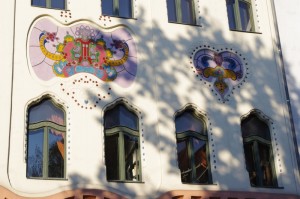
Kecskemét Ornamental Palace
The road from Gyula to Kecskemét is lined with water-melon stalls, which look as if they’ve fared much better in gardens than the fields of maize and blackened sunflowers. After reaching Kecskemét, we are seduced into staying a second day by the returning sunshine, pavement cafés, fountains, museums, good food and abundance of art nouveau (or Austro-Hungarian secessionist style) architecture. We also relish our pension with its verdant courtyard garden, great breakfast, friendly owner and immaculate rooms (pink and tiny in our case, as the larger garden rooms are taken – it feels a bit like sleeping in a Barbie house). So after simply strolling round on the first afternoon and having a splendid dinner (in an art-nouveau brasserie style setting, of course) we are more earnest on our second day. We visit the big morning market (colourful flowers and vegetables outside, and meat, cheese and pickled vegetables inside), then the ornate Council Chamber. We admire the art nouveau architecture (despite the strange roof ornaments which have a distinctly Disneyland look), 20th century paintings, old photographs and gold grave goods in the Ornamental Palace. After a pause for the best-ever Sachertorte and coffee at Vincent’s, we proceed to the museums of naïve art and of Hungarian crafts. Dinner in the evening is at a more traditional restaurant/bar, very filling and jolly too with men are playing (for money) with huge cards with Roman numerals.
Next we head for the university town and home of paprika, Szeged. On the way we stop at a large memorial/heritage park. The part that interests us most contains re-constructed houses from the area, which from the outside look like the houses we have driven past, so it is fun to see inside. Not only are “inhabitants” on hand to chat about their lifestyle (the miller’s wife is also busy whitewashing the big mill), but the gardens are full of typical produce, there are pigs in the sties, chickens pecking around, peppers strung up to dry, and the loos outside the school are much as I remember from junior school.
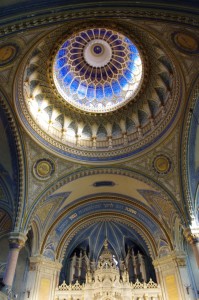
Szeged Old Synagogue
The first place we head for in Szeged is the old synagogue. The synagogues in Tokai and Kecskemét had seemed large, but this domed, yellow brick edifice in gloomy overgrown shrubbery is even larger (and would look at home on the Cromwell Road). Inside the walls and dome are an opulent cream and blue starred with gold, and the windows are colourful but the atmosphere is dusty and sad. The long, long lists of those who perished in the last war are engraved round the entrance hall, – a thriving community martyred. John replaces his borrowed yarmulke (it suited him) in the box, and we continue past an unexpected Indian/Pakistan restaurant to look at the art nouveau architecture (especially the flamboyant mauve irises over the walls of the Reök Palace) and the river Tisza. The streets and squares are very busy, with trikes, scooters, hoppers and stilts being packed away in one square as children leave with balloons, people queuing with large containers at one of the fountains, and trams and cyclists everywhere.
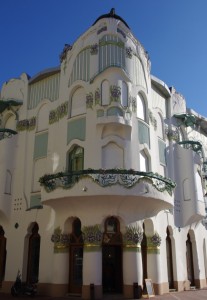
Szeged Reök Palace
Later in the evening the traffic comes to a standstill as a whistling and shouting procession of cyclists with torches encircles one of the squares. Students? But there are children and older people too. Two policemen say they don’t know what it is about. Later still, in the cathedral there is a concert of modern, haunting music. And as we stand under the Heroes’ gateway in the dark, trying to make out its murals, the car headlights flash past. We don’t get to the salami and paprika museum, but we have our most memorable meal here, no not Ind/Pak curry, but chicken stuffed with asparagus with a pesto sauce and parmesan or chicken with roasted vegetables and cheese and leek sauce, followed by a chestnut soufflé. The chef has just been lured to Szeged from Budapest.
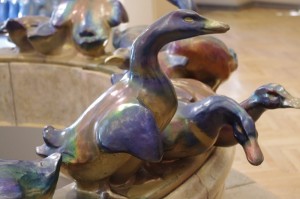
Pécs – Zsolnay Porcelain Museum
Pécs, the last of our southern cities, is equally enjoyable. We reach it via small scraggy vineyards, fields of scarlet pimentos being harvested, and a single track forest railway line which seems to have packed up for the year. Pécs is in the middle of a music and dance festival, so most small accommodation is full and we don’t like the big communist era chain hotel (no wonder it still has a room) that grudgingly offers a single night. So we cram as much as possible into our curtailed stay. The highlights for us are the six fourth century Christian burial sites linked by modern tunnels and galleries beneath the cathedral precincts, the resplendent Zsolnay Porcelain Museum (including its art nouveau and art deco designs and with very informative text), the Turkish mosque (built with the stones of a Gothic church, and once more a Catholic church with a semi-circular add-on with dramatic murals) and a solitary Scot extracting the most beautiful music we’ve ever heard from a bagpipe outside Murphy’s Bar. Instead of a second night in a grotty Pécs hotel, we turn north-west to Kaposvar and an agreeable art nouveau hotel. Here we make the most of the last sunny evening, enjoying the statues, fountains, pedestrian street and art nouveau café.
And then, after driving round one end of Lake Balaton (where we might have stayed, but for the approaching rain), we are back, almost full circle, to Romanesque churches near the western border with Austria and the problems of finding the keyholder. So here are three last scenes.
The buildings round the gloomy looking church at Türje must once have been monastic but have the sad air of a former residence for delinquent boys or lunatics. However the shabby young man loafing outside is most keen to help us and does a vivid mime of an ageing keyholder who has gone home for his lunch but will return on his motorcycle (noisy revs) soon after two o’clock. As we wait, John takes photos of Bluto ignoring the old Trabant outside and of the crumbling farm buildings, and then we hear the approaching motorcycle and get a thumbs up from our helper. Inside the church is equally gloomy, with baroque flourishes, but a wonderful fragment of mediaeval mural on the south wall showing St Ladislaus on horseback in battle (in a scene reminiscent of the Bayeux tapestry), has survived the Turks and rebuilding. The mural is lovely and it’s sad the church feels neglected.
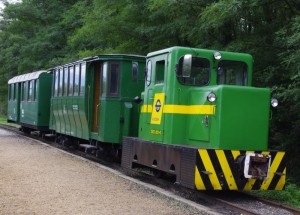
Nagycenk Railway Museum and Kastély-Fertöboz narrow-gauge railway
Next day, on our last afternoon in Hungary, we indulge in a ride on a narrow gauge train, followed by and a search for another keyholder. A train is just about to leave as we reach the tiny station (staffed by older children) next to the outdoor locomotive museum at Nagycenk, so we hastily buy tickets. The two wooden-seated carriages, drawn today by a small diesel engine (steam on some weekends), lurch off along the track through fields and over level crossings till the we reach the “big” (main line) station and more old rolling stock. The return journey involves a flag-waving guard leaning out of our carriage door, as the engine is now at the rear and the driver doesn’t have a clear view. This nostalgia for the old farm and forest railways has been rather fun.

Hidegség parochial church
Getting into the Romanesque church two km away at Hidegség proves more complicated as the key holder, Jozsef, is not at home, though his little dog makes a lot of noise. Finally the bar owner gives us his mobile number. It sounds as if he and his wife are picking apples somewhere, but in a quarter of an hour he arrives, as promised, and opens up the eastern section of the church. At first we are just stunned by the frescoes round the east window, and only later start to piece together the history of this church, built on the site of a circular Roman watchtower. Inside the church is a rotunda, but it has strong, square outside walls around it. A later baroque altar has been taken down and the more recent extensions have been separated off by a wall. With its low stone altar and old font (still in use for baptisms), it must look closer to its original shape than most churches we’ve seen so far. Jozsef lights the candles as John takes photographs of the thirteenth century central figure of Christ in majesty surrounded by the symbols of the evangelists and below them nine disciples (sadly three vanished when an enclosing wall was removed at some stage). There are also some sixteenth century disciples, in a more flowing style, round the main dome. The Turks removed the features from the faces and the Protestants whitewashed the lot. Now the church is Catholic again, and the preservation work has been thorough. As Jozsef returns to his apples, we stop for a long, warming coffee in the bar that helped us, and the rain starts again.
Sadly we have reached the end of our two-week journey round Hungary. All that remains is to spend our last Hungarian forints on a bed, dinner, some apricot and cherry brandy and a few bottles of wine, before crossing back into euro-land and returning to Entre-deux-Eaux via Lake Constance and the Black Forest. It has been a good holiday.

